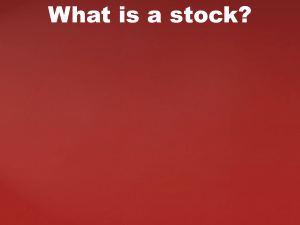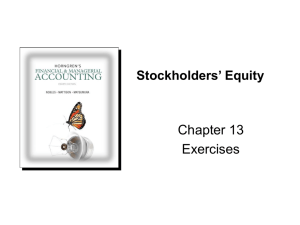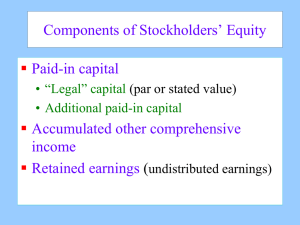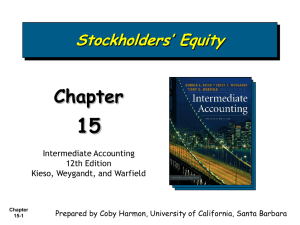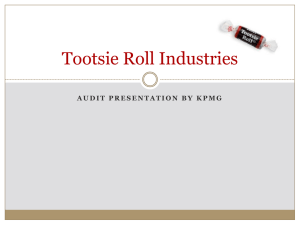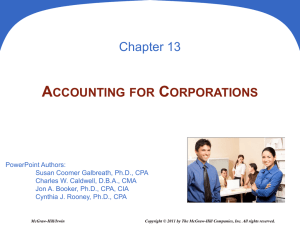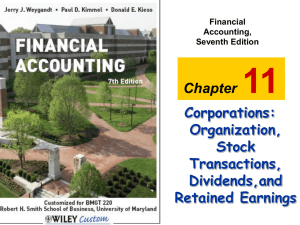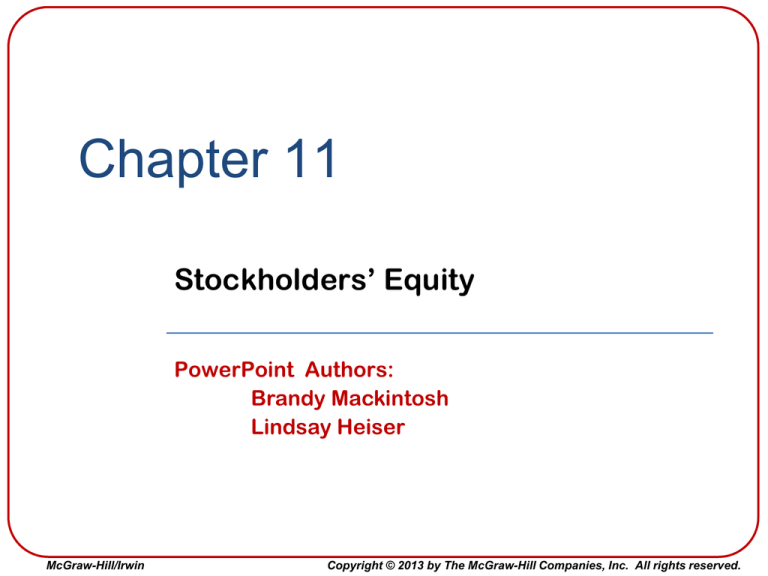
Chapter 11
Stockholders’ Equity
PowerPoint Authors:
Brandy Mackintosh
Lindsay Heiser
McGraw-Hill/Irwin
Copyright © 2013 by The McGraw-Hill Companies, Inc. All rights reserved.
Learning Objective 11-1
Explain the role of stock in
financing a corporation
11-2
Corporate Ownership
The major advantage of the corporate form of business
is the ease of raising capital as both large and small
investors can participate in corporate ownership.
Simple to
become an
owner
Easy to
transfer
ownership
Provides
limited
liability
Because a corporation is a separate legal entity, it can
Own assets.
Incur liabilities.
Sue and be sued.
Enter into contracts.
11-3
Corporate Ownership
Voting rights.
Dividends.
Stockholder
Benefits
Residual claims.
Preemptive rights.
11-4
Corporate Ownership
11-5
Equity Versus Debt Financing
Advantages of equity and debt financing.
11-6
Advantages of equity
Advantages of debt
• Equity does not have to
be repaid.
• Interest on debt is tax
deductible.
• Dividends are optional.
• Debt does not change
stockholder control.
Learning Objective 11-2
Explain and analyze common
stock transactions.
11-7
Common Stock Transactions
Contributed
Capital
Accumulated
Other
Comprehensive
Income
Stockholders’
Equity
Treasury
Stock
11-8
Retained
Earnings
Authorization, Issuance, and
Repurchase of Stock
Authorized
Shares
Issued
Shares
11-9
Outstanding shares are
issued shares that are
owned by stockholders.
Issued
Unissued
shares are
shares of
Outstanding
The maximum number
Unissued
authorized
stock are
Shares
of shares
of capital
Shares
shares
of
shares
that
be never
stockstock
that that can
have
Treasury
haveissued
been to the public.
been shares are
Treasury
issued shares
distributed to
distributed
to that have
Shares
been reacquired by the
stockholders.
stockholders.
corporation.
Authorization, Issuance, and
Repurchase of Stock
11-10
Stock Authorization
Par value is typically a very
nominal amount such a $0.01
per share.
Par value is an
arbitrary amount
assigned to each
share of stock when it
is authorized.
11-11
Market price is the
amount that each
share of stock will sell
for in the market.
Stock Authorization
No-par Stock
Some states
do not
require a par
value to be
stated in the
charter.
11-12
Stock Issuance
Initial public offering
(IPO)
Seasoned new issue
The first time a
corporation issues
stock to the public.
Subsequent issues
of new stock to the
public.
National Beverage
issues stock.
11-13
Stock Issuance
Most issues of stock to the public are cash transactions.
National Beverage issued 100,000 shares of
$0.01 par value common stock for $10 per share.
1
Analyze
Assets
Cash +1,000,000
2
Liabilities
+
Stockholders’ Equity
Common Stock
+1,000
Additional Paid-In
Capital
+999,000
Record
dr
11-14
=
1,000,000
Cash (+A) (100,000 x $10)
1,000
cr Common Stock (+SE) (100,000 x $0.01)
cr Additional Paid-In Capital (+SE)
999,000
(1,000,000 – 1,000)
Stock Exchanged between
Investors
Transactions between two investors do not
affect the corporation’s accounting records.
I’d like to sell 100
shares of National
Beverage stock.
11-15
I’d like to buy 100
shares of National
Beverage stock.
Stock Used to Compensate
Employees
Employees pay
packages can
include stock
options
Gives the employees the option to acquire
company stock at a predetermined price
If the employees work hard and meet the
corporation’s goals the stock price will increase.
Employees can then exercise their option to
acquire stock at the lower predetermined price
and sell it at the higher price for a profit.
11-16
Repurchase of Stock
A corporation repurchases its stock to:
Distribute excess cash to stockholders.
Send a signal that the company believes
its stock is worth acquiring.
Obtain shares to reissue for the purchase
of other companies.
Obtain shares to reissue to employees as
part of stock option plans.
11-17
Repurchase of Stock
National Beverage
repurchases its
own stock
(Treasury stock)
Stockholders
Employee
compensation
package includes
salary plus stock
options.
Stock options allow
employees to purchase
stock from the corporation
at a fraction of the stock’s
market price.
Employee
11-18
Repurchase of Stock
No voting
or
dividend
rights
Contra
equity
account
Treasury
stock is not
an asset.
When stock is reacquired, the corporation
records the treasury stock at cost.
11-19
Repurchase of Stock
National Beverage reacquired 50,000 shares
of its common stock at $25 per share.
1
Analyze
Assets
=
Liabilities
Cash -1,250,000
2
Stockholders’ Equity
Treasury
Stock (+xSE)
-1,250,000
Record
dr
11-20
+
Treasury Stock (+xSE, -SE)
cr Cash (-A)
1,250,000
1,250,000
Reissuance of Treasury Stock
National Beverage reissued 5,000 shares
of the Treasury Stock at $28 per share.
1
Analyze
Assets
Cash +140,000
2
=
Liabilities
+
Stockholders’ Equity
Treasury Stock (-xSE) +125,000
Additional Paid-In
Capital
+15,000
Record
dr
140,000
Cash (+A) (5,000 x $28)
cr Treasury Stock (-xSE, +SE) (5,000 x $25)
cr Additional Paid-In Capital (+SE)
[5,000 x ($28 - $25)]
125,000
15,000
No profit or loss is recognized on treasury stock transactions.
11-21
Learning Objective 11-3
Explain and analyze cash
dividends, stock dividends,
and stock split transactions.
11-22
Dividends on Common Stock
Declared by board
of directors.
Not legally
required.
Creates liability at
declaration.
Requires sufficient Retained
Earnings and Cash.
11-23
Dividends Dates
11-24
Dividends Dates
National Beverage declares an $2.30 dividend on each share
of its 46,200,000 shares of common stock outstanding.
1
Analyze
Assets
=
Liabilities
Dividends
Payable +106,260,000
2
Stockholders’ Equity
Dividends
Declared (+D) -106,260,000
Record
dr
11-25
+
Dividends Declared (+D, -SE)
cr Dividends Payable (+L)
106,260,000
106,260,000
Dividends Dates
National Beverage paid the previously declared $2.30
dividend on its shares of common stock outstanding.
1
Analyze
Assets
Cash -106,260,000
2
+
Stockholders’ Equity
Dividends
Payable -106,260,000
Record
dr
11-26
Liabilities
=
Dividends Payable (-L)
cr Cash (-A)
106,260,000
106,260,000
Stock Dividends
Distribution of additional shares
of stock to stockholders.
No change in total
stockholders’ equity.
No change in
par values.
All stockholders retain same
percentage ownership.
Corporations issue stock dividends to:
Remind stockholders of the accumulating wealth in the company.
Reduce the market price per share of stock.
Signal that the company expects strong financial performance
in the future.
11-27
Stock Dividends
Small
Large
Stock dividend < 20 – 25%
Stock dividend > 20 – 25%
Record at current
market value
of stock.
Record at
par value
of stock.
The journal entry moves an amount from
Retained Earnings to other equity accounts.
11-28
Stock Dividends
National Beverage issued a 20 percent stock dividend on
38,000,000 outstanding shares of its $0.01 par value
common stock and accounted for it as a large stock
dividend.
1
Analyze
Assets
=
Liabilities
+
Stockholders’ Equity
Retained Earnings -76,000
Common Stock +76,000
2
Record
dr
11-29
Retained Earnings (-SE)
cr Common Stock (+SE)
76,000
76,000
Stock Splits
An increase in the number of shares and a corresponding decrease
in par value per share. Retained earnings is not affected.
A stock split creates more
pieces of the same pie.
Assume that a corporation had 1,000,000 shares of $0.01 par
value common stock outstanding before a 2–for–1 stock split.
11-30
Comparison of Distributions
to Stockholders
11-31
Learning Objective 11-4
Describe the characteristics of
preferred stock and analyze
transactions affecting
preferred stock.
11-32
Preferred Stock Issuance
Priority over common stock
Preferred Stock
Usually has a fixed dividend rate
Usually has no voting rights
National Beverage issued 10,000 shares of its
$1 par value preferred stock for $5 per share.
1
Analyze
Assets
Cash +50,000
2
Liabilities
+
Stockholders’ Equity
Preferred Stock
Additional Paid-In
Capital Preferred
+10,000
+40,000
Record
dr
11-33
=
50,000
Cash (+A) (10,000 x $5)
cr Preferred Stock (+SE) (10,000 x $1)
cr Additional Paid-In Capital – Preferred (+SE)
10,000
40,000
Preferred Stock Dividends
• Current Dividend Preference: The current
preferred dividends must be paid before
paying any dividends to common stock.
• Cumulative Dividend Preference: Any
unpaid dividends from previous years
(dividends in arrears) must be paid before
common dividends are paid.
If the preferred stock is noncumulative, any
dividends not declared in previous years are lost
permanently.
11-34
Preferred Stock Dividends
Assume the preferred stock of Flavoria carries
only a current dividend preference and that the
company declares dividends totaling $8,000 in
2012 and $10,000 in 2013. How much would
the preferred and common stockholders receive
in 2012 and 2013?
11-35
Preferred Stock Dividends
11-36
Preferred Stock Dividends
Assume that Flavoria Company has the same
amount of stock outstanding. However assume
that dividends are in arrears for 2010 and 2011.
How much would the preferred and common
stockholders receive in 2012 and 2013?
11-37
Preferred Stock Dividends
11-38
Retained Earnings
Total cumulative amount of reported net income less any
net losses and dividends declared since the company
started operating.
Baker Company
Comparative Balance Sheets (Partial)
For Year Ended December 31
Stockholders’ Equity
Common Stock
Additional Paid-in Capital
Retained Earnings (Deficit)
Total Stockholders’ Equity
2014
2013
$ 100,000
750,000
50,000
900,000
$ 100,000
750,000
(70,000)
780,000
Baker Company incurred a loss of $120,000 in 2013 that
resulted in an Accumulated Deficit in Retained Earnings.
11-39
Learning Objective 11-5
Analyze the earnings per
share (EPS), return on equity
(ROE), and price/earnings
(P/E) ratios.
11-40
Earnings Per Share (EPS)
Earnings per share is probably the single
most widely watched financial ratio.
Net Income
EPS =
Average Number of Common Shares Outstanding
National Beverage’s income for 2011 was
$40,800,000 and the average number of shares
outstanding during the year was 46,200,000.
EPS =
11-41
$40,800,000
46,200,000 Shares
= $0.88 per share
Return on Equity (ROE)
Return on equity is the amount earned
for each dollar invested by stockholders.
ROE
=
Net Income
Average Stockholders’ Equity
National Beverage’s income for 2011 was
$40,800,000 and the average Stockholders’
Equity was $110,950,000.
ROE
11-42
=
$40,800,000
$110,950,000
=
36.8 percent
Price/Earnings (P/E) Ratio
The P/E ratio is a measure of the value that
investors place on a company’s common stock.
P/E
=
Current Stock Price (per share)
Earnings Per Share (annual)
National Beverage’s stock price was $15.10 when
the company reported its 2011 EPS of $0.88.
P/E
11-43
=
$ 15.10
=
$ 0.88
17.2
Comparison of EPS, ROE,
and P/E Ratios
11-44
Supplement 11A
Owners’ Equity for Other Forms of
Business
McGraw-Hill/Irwin
Copyright © 2013 by The McGraw-Hill Companies, Inc. All rights reserved.
Owner’s Equity for a Sole
Proprietorship
Only two owner’s
equity accounts.
11-46
A Capital account to record
the owner’s investments
and the periodic income
or loss.
A Withdrawal account
to record the owner’s
withdrawals of assets.
No separate retained
earnings account.
Closed to the capital account
at the end of each period.
Accounting for Owner’s Equity
for a Sole Proprietorship
To record a $150,000 investment by H. Simpson, the owner.
To record H. Simpson’s $1,000 monthly withdrawal.
11-47
Accounting for Owner’s Equity
for a Sole Proprietorship
To close revenue and expense accounts to capital.
To close the $1,000 monthly drawings to capital.
11-48
Accounting for Partnership Equity
Accounting for assets, liabilities, revenues and
expenses follows the same accounting principles as
any other form of business.
Accounting for partners’ equity follows the same
pattern as for a sole proprietorship.
Separate Capital and Drawings accounts are
maintained for each partner.
11-49
Accounting for Partnership Equity
To record investments by partners Able and Baker
who will divide net income as follows: Able, 60
percent and Baker 40 percent.
To record the partners’ monthly withdrawal.
11-50
Accounting for Partnership Equity
To close revenue and expense accounts to partners’ capital.
To close the monthly drawings to partners’ capital.
11-51
Other Business Forms
Limited
Liability
Partnership
(LLP)
11-52
Limited
Liability
Company
(LLC)
• Protects innocent
partners from
malpractice or
negligence claims.
• Owners have same
limited liability
feature as owners
of a corporation.
• Most states hold all
partners personally
liable for partnership
debts.
• A limited liability
company typically
has a limited life.
Chapter 11
Solved Exercises
M11-4, M11-8, E11-3, E11-6, E11-8,
E11-11, E11-19
McGraw-Hill/Irwin
Copyright © 2013 by The McGraw-Hill Companies, Inc. All rights reserved.
M11-4 Analyzing and Recording the Issuance of Common Stock
To expand operations, Aragon Consulting issued 1,000 shares of previously
unissued common stock with a par value of $1. The price for the stock was
$50 per share. Analyze the accounting equation effects and record the journal
entry for the stock issuance.
1
Analyze
Assets
=
Liabilities
Cash +50,000
2
Stockholders’ Equity
Common Stock
+1,000
Additional Paid-In
Capital
+49,000
Record
dr
11-54
+
Cash (+A)
cr Common Stock (+SE)
cr Additional Paid-In Capital (+SE)
50,000
1,000
49,000
M11-4 Analyzing and Recording the Issuance of Common Stock
Would your answer be different if the par value were $2 per share? If, so,
analyze the accounting equation effects and record the journal entry for the
stock issuance with a par value of $2.
The effects on total assets and total stockholders’ equity would not differ, but
the amounts within the individual stockholders’ equity accounts would differ.
1
Analyze
Assets
=
Liabilities
Cash +50,000
2
Stockholders’ Equity
Common Stock +2,000
Additional Paid-In
Capital
+48,000
Record
dr
11-55
+
Cash (+A)
cr Common Stock (+SE)
cr Additional Paid-In Capital (+SE)
50,000
2,000
48,000
M11-8 Determining the Amount of a Dividend
Netpass Company has 300,000 shares of common stock authorized, 270,000
shares issued, and 100,000 shares of treasury stock. The company’s board of
directors declares a dividend of $1 per share of common stock. What is the
total amount of the dividend that will be paid?
Dividends are paid on shares that are issued and outstanding.
Dividends are not paid on treasury stock.
Shares issued
270,000
Less treasury stock
100,000
Shares outstanding
170,000
Dividend per share
Total dividends paid
11-56
x $
1.00
$170,000
End of Chapter 11
11-57



